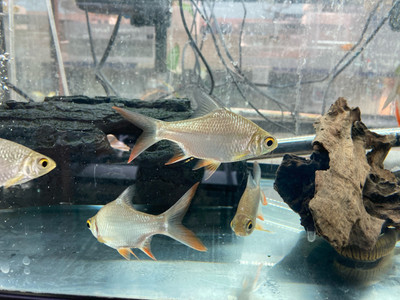Tin Foil Barb
Posted by Max Gandara on on 1st Jun 2023
The Tin Foil Barb (Puntius schwanenfeldii) is a captivating freshwater
fish that has garnered significant attention among aquarium enthusiasts.
Known for its distinctive appearance and engaging behavior, this
species offers aquarists a unique and rewarding experience. In this
article, we will explore the characteristics, care requirements, and
intriguing aspects of the Tin Foil Barb.
Physical Appearance:
One of the most striking features of the Tin Foil Barb is its shiny,
metallic body. Its name is derived from the resemblance of its scales to
tin foil, reflecting light beautifully in an aquarium setting. These
fish have a streamlined shape with a high-backed profile and an
elongated dorsal fin. Their coloration can vary, ranging from silver to
golden hues, and their fins may display subtle reddish or orange tones.
Native Habitat and Distribution:
The Tin Foil Barb originates from Southeast Asia, specifically in the
rivers and streams of Thailand, Borneo, Sumatra, and Cambodia. They are
primarily found in slow-moving freshwater bodies, including rivers,
lakes, and flooded forests. Their natural habitat is often densely
vegetated, providing them with ample hiding places and suitable
conditions for their well-being.
Tank Requirements:
To ensure the optimal health and well-being of Tin Foil Barbs, it is
crucial to provide them with an adequately sized aquarium. Ideally, a
tank with a capacity of at least 75 gallons (284 liters) is recommended
for a small group of Tin Foil Barbs. These fish appreciate open swimming
spaces, so it's essential to provide enough room for them to move
freely. Additionally, a well-filtered tank with regular water changes is
necessary to maintain good water quality.
Water Parameters:
Tin Foil Barbs thrive in water conditions that resemble their natural
habitat. The water temperature should be maintained between 72°F and
82°F (22°C to 28°C), while the pH level should range from 6.5 to 7.5.
They prefer slightly soft to moderately hard water, with a dGH (degrees
of general hardness) of 8-12.
Feeding Habits:
These fish are omnivorous, and in the wild, they feed on various types
of plant matter, insects, crustaceans, and small aquatic organisms. In
captivity, a balanced diet consisting of high-quality flake or pellet
food, supplemented with occasional live or frozen foods such as
bloodworms, brine shrimp, and daphnia, will ensure their nutritional
needs are met.
Behavior and Compatibility:
Tin Foil Barbs are known for their energetic and active nature. They are
schooling fish, which means they thrive when kept in groups of at least
five individuals. Keeping them in larger groups will provide them with a
sense of security and reduce stress. It's important to note that Tin
Foil Barbs can grow quite large, reaching up to 14 inches (35 cm) in
length, so tankmates should be chosen with care. Compatible tankmates
include other large, active species such as barbs, danios, and larger
cichlids. Avoid keeping them with small, delicate fish that may become
targets of their playful behavior.
Breeding:
Breeding Tin Foil Barbs in captivity can be challenging, and it often
requires specific conditions to trigger the spawning behavior. In a
well-maintained breeding tank with suitable water parameters, a separate
pair can be introduced. The presence of plants, dimmed lighting, and an
increase in water temperature can stimulate spawning. After successful
spawning, the parents should be removed to prevent them from eating
their own eggs. The eggs usually hatch within 24 to 48 hours, and the
fry can be fed with infusoria or

